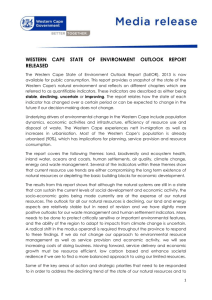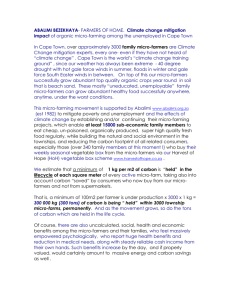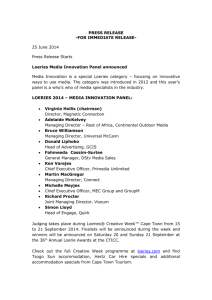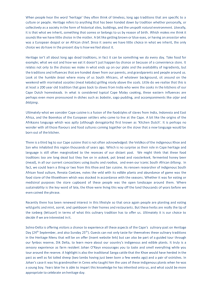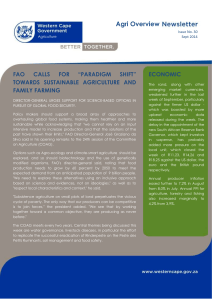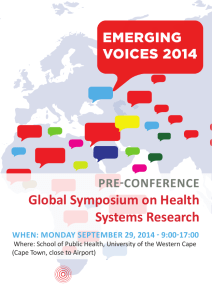L2 Flmbos case study handout
advertisement
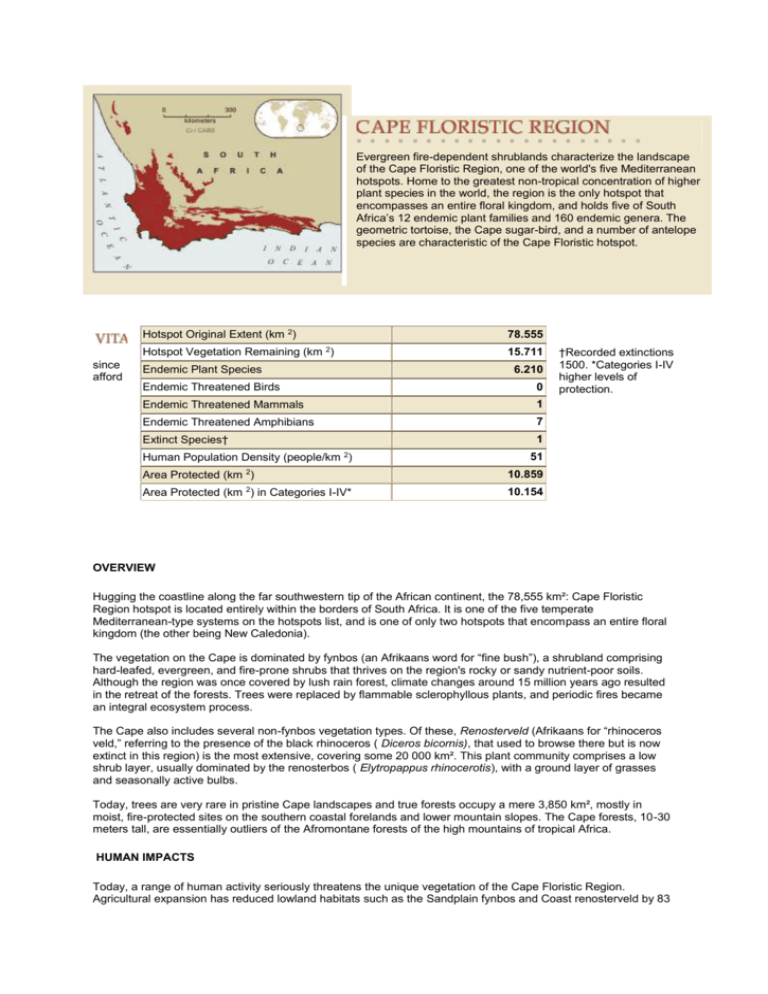
Evergreen fire-dependent shrublands characterize the landscape of the Cape Floristic Region, one of the world's five Mediterranean hotspots. Home to the greatest non-tropical concentration of higher plant species in the world, the region is the only hotspot that encompasses an entire floral kingdom, and holds five of South Africa’s 12 endemic plant families and 160 endemic genera. The geometric tortoise, the Cape sugar-bird, and a number of antelope species are characteristic of the Cape Floristic hotspot. Hotspot Original Extent (km 2) Hotspot Vegetation Remaining (km since afford 78.555 2) 15.711 6.210 Endemic Plant Species Endemic Threatened Birds 0 Endemic Threatened Mammals 1 Endemic Threatened Amphibians 7 Extinct Species† †Recorded extinctions 1500. *Categories I-IV higher levels of protection. 1 Human Population Density (people/km Area Protected (km 2) Area Protected (km 2) 2) 51 10.859 in Categories I-IV* 10.154 OVERVIEW Hugging the coastline along the far southwestern tip of the African continent, the 78,555 km²: Cape Floristic Region hotspot is located entirely within the borders of South Africa. It is one of the five temperate Mediterranean-type systems on the hotspots list, and is one of only two hotspots that encompass an entire floral kingdom (the other being New Caledonia). The vegetation on the Cape is dominated by fynbos (an Afrikaans word for “fine bush”), a shrubland comprising hard-leafed, evergreen, and fire-prone shrubs that thrives on the region's rocky or sandy nutrient-poor soils. Although the region was once covered by lush rain forest, climate changes around 15 million years ago resulted in the retreat of the forests. Trees were replaced by flammable sclerophyllous plants, and periodic fires became an integral ecosystem process. The Cape also includes several non-fynbos vegetation types. Of these, Renosterveld (Afrikaans for “rhinoceros veld,” referring to the presence of the black rhinoceros ( Diceros bicornis), that used to browse there but is now extinct in this region) is the most extensive, covering some 20 000 km². This plant community comprises a low shrub layer, usually dominated by the renosterbos ( Elytropappus rhinocerotis), with a ground layer of grasses and seasonally active bulbs. Today, trees are very rare in pristine Cape landscapes and true forests occupy a mere 3,850 km², mostly in moist, fire-protected sites on the southern coastal forelands and lower mountain slopes. The Cape forests, 10-30 meters tall, are essentially outliers of the Afromontane forests of the high mountains of tropical Africa. HUMAN IMPACTS Today, a range of human activity seriously threatens the unique vegetation of the Cape Floristic Region. Agricultural expansion has reduced lowland habitats such as the Sandplain fynbos and Coast renosterveld by 83 percent and 48 percent of their original extent, respectively. Much of what remains exists in isolated fragments in a matrix of chemically treated agriculture. Agricultural development is encroaching on natural areas even in the mountains, where impoverished soils previously limited agriculture; farming of rooibos tea, ( Aspalathus linearis), honeybush tea ( Cyclopia spp.), cut flowers (mainly Proteaceae), and, of course, vineyards pose a significant threat to the remaining vegetation. In addition, urban encroachment and development, particularly near the city of Cape Town, is a threat to natural habitats. Although urban and industrial areas currently occupy less than 1 percent of the land area in the hotspot, population is growing rapidly; Cape Town's population is expected to double by the year 2025. However, the greatest threat to this hotspot is the effect of invasive alien plant species. For decades, trees and shrubs from other Mediterranean-type climates such as southern Australia, the Mediterranean Basin, and California have been introduced into the region to supplement the few tree species native to the Cape. These alien species have invaded about 70 percent of mountain and lowland fynbos, altering natural fire frequencies, diminishing mountain-derived water production, and ultimately eliminating native species. Overall, some 33 percent of the Cape Floristic Region has been transformed by agriculture, urbanization and dense stands of alien invasive plants. However, only about 15,700 km², or 20 percent, is in pristine condition, being free of invasive alien plants and subject to appropriate fire regimes. CONSERVATION ACTION AND PROTECTED AREAS According to the World Database on Protected Areas, about 10,859 km², representing about 14 percent of the total land area, in the Cape Floristic Region is in protected areas, nearly all of it in IUCN categories I to IV. However, this land is far from representative of the hotspot's full diversity; while 50 percent of the mountain landscapes are conserved, only nine percent of the lowlands, which are the most vulnerable, are under some form of protection. Although the high costs of land purchase and park management activities have posed serious challenges to conservation in the region, a number of recent successes point to a more optimistic future for the hotspot's biodiversity. These achievements have helped to strengthen the already tremendous level of public awareness about the value of the province and its fauna and flora. Among many promising projects is an initiative called the Working for Water Programme, which focuses on the removal of alien plants to encourage the regeneration of native vegetation and protection of watersheds. The program has created 3,600 jobs in the region and led to the clearing of nearly 500 km² of alien growth, one of the most impressive efforts of its kind in the world. There have also been a number of triumphs in the establishment of new protected areas, including the Cape Peninsula National Park, the Cape Agulhas National Park, and the West Coast Biosphere Reserve. At a recent meeting in Suzhou, China, UNESCO recognized the importance of this region by declaring it a World Heritage Site for its "outstanding universal significance to humanity." Eight protected areas together comprise the Cape Floristic Region World Heritage Site, one of which includes Kirstenbosch National Botanical Garden, the first time that a botanical garden has been recognized as a world heritage site for its biodiversity. The areas included in the world heritage site are Table Mountain, Baviaanskloof, De Hoop Nature Reserve, Boland Mountain Complex, Groot Winterhoek Wilderness Area, Swartberg Complex, Boosmansbos Wilderness Area, and Cederberg Wilderness Area. These eight separate protected areas total more than 553,000 hectares, making this World Heritage Site the richest for plants in the world on a per area basis. It is hoped that UNESCO listing will help to encourage the 'biodiversity economy' in the region, and will promote eco-tourism and better planning and management of the region's incredibly rich natural resources, protected areas, and scenic landscapes for the benefit of all South Africans. Already, the Cape Action Plan for the Environment, a $6 million project funded by the GEF and World Bank, is supporting the development and implementation of a strategic plan for sustainable conservation of the hotspot's unique flora and fauna, and a $6 million investment by the Critical Ecosystem Partnership Fund is being used partially to support three megareserves: Baviaanskloof, Cederberg and Gouritz, and to build the capacity of previously disadvantaged local conservationists.

